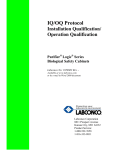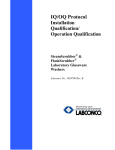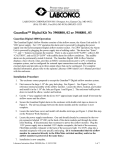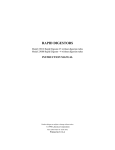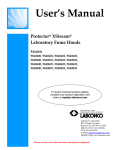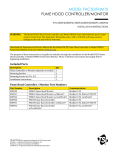Download + IQ/OQ Protocol Installation Qualification
Transcript
+ IQ/OQ Protocol Installation Qualification/ Operation Qualification Protector® Series Laboratory Fume Hoods Labconco No: 1060200 Available at www.labconco.com or by e-mail in Word 2000 document Labconco Corporation 8811 Prospect Avenue Kansas City, MO 64132 Product Service: 1-800-522-7658 1-816-333-8811 Labconco Protector Series Laboratory Fume Hoods IQ/OQ Protocol #1060200 Revision A Purpose and Scope This Qualification Protocol is solely intended to be used with Labconco Protector® Fume Hoods, which are new or relocated. It is written to assist the end-user in validation of predetermined specifications. The protocol begins with planning the site for the piece of equipment and therefore is of value prior to receipt of delivery. Responsibilities End-User – The ultimate user or otherwise appointed personnel in the lab is responsible to ensure the fume hood is installed and operating properly. This document can assist in that validation. This document cannot however anticipate every application or unique situation encountered with the installation and operation. It is therefore essential that users, lab managers and safety officers work together to broaden the scope of this document through cautious forethought. End-User Employer – The employer is responsible for supporting the validation through adequate resources and training. The organization shall also ensure the validation process has been fully carried out prior to use of the fume hood. Records should be stored in a safe, easily retrievable location. The location of the fume hood, preventive maintenance and certification schedules should be documented in the company’s quality system. Fume Hood Certifier – All fume hoods should be certified prior to use. A qualified certifying technician must do this process with calibrated instruments. The fume hood should be certified upon installation, on a scheduled annual basis and whenever the fume hood is moved to a new location. Certification is the key requirement of this protocol. Manufacturer – Labconco Corporation, certified ISO-9001, is responsible to fully test respective Protector® Fume Hoods, using the ASHRAE test protocol, to ANSI Z9.5 requirements prior to shipment. The manufacturer must retain inspection records. Their staff of Product Service Representatives and Product Specialists can assist with information on the purchase, delivery and installation. Labconco is not responsible for carrying out the actual installation or validation processes. 1 Labconco Protector Series Laboratory Fume Hoods IQ/OQ Protocol #1060200 Revision A Performance Qualification Once the Protector Fume Hood has been checked for proper installation and operation, its performance may be validated. Labconco cannot recommend specific procedures to do this. The performance validation should be designed to meet the specifications and accuracy required of the application. In general this requires establishing acceptance criteria, inspecting and testing the results with calibrated equipment and qualified personnel. Some basic suggestions are included after the Operational Qualification section. 2 Labconco Protector Series Laboratory Fume Hoods IQ/OQ Protocol #1060200 Revision A A. Installation Qualification Step Description 1 Site Planning 1a Proper airflows Specification or Acceptance Criteria Result YES NO Is the fume hood to be located in a room with windows that will remain closed? Y N Is the fume hood to be located away from heavy foot traffic, doors, fans, ventilation registers and any other air-handling devices that could disrupt its airflow patterns? Y N 1b Mounting Surface Have accommodations been made for placement of the fume hood on a work surface, cabinetry or stand of suitable strength and proper height? Y N 1c Space Requirements Refer to Appendix B in User’s Manual. Has adequate floor space been provided for placement of the base cabinet? Y N Has a facilities manager or qualified HVAC person reviewed and approved the site plans for placement of exhaust duct? Y N 1d Service line Requirements N/A Have the exhaust blower, ductwork and dampers been ordered? Y N Has the room/building been evaluated for adequate air changes with the device? Y N Has the facilities manager been consulted with regard to water, gas or vacuum service requirements? Y N Y N/A N Does the fume hood ordered/received have service valves to match expectations? Connections to the water service valves are 3/8" OD tubing. Connections to all other service valves are 1/4" OD metal tubing and require a shut-off valve. WARNING: If the service line pressure exceeds 40 PSI, it must be equipped with a pressure regulator to reduce the line pressure. Check local codes for other requirements. 3 Labconco Protector Series Laboratory Fume Hoods IQ/OQ Protocol #1060200 Revision A 1e Airflow Monitoring Requirements If desired, has an airflow monitor been ordered for use with this fume hood? (Monitors are recommended on all hoods.) Y N/A N 1f Electrical Service Depending upon model and user requirements, exhaust blower may be turned on by a switch on the hood or remotely. Are services available for the fume hood to be connected to a dedicated circuit with over-current protection of adequate size and the proper voltage? (Refer to User’s Manual or consult Labconco for ratings.) Y N 1g Delivery Requirements If the fume hood has not been delivered, have arrangements been made with the facility or delivery agent to have equipment capable of gently handling a packaged skid of this size and weight? (Refer to Chapter 3 of the User’s Manual.) Y N Is there a clear path from the loading platform to the final destination in the lab? Y N When required, will there be equipment to move the fume hood onto the final mounting surface/stand? (Refer to the Getting Started section of User’s Manual) Y N Has the fume hood been inspected for any signs of damage that may have occurred while in transit or within the building? Keep packaging materials until inspection is complete. Y N The fume hood has been mounted to a substantial supporting stand or cabinet that has been checked for level? Y N The cabinet or stand is set at a suitable height for the operator to work ergonomically? Y N 2 Prior to Operation 2a Damage Claims If so, refer to the User’s Manual for information on shipping damage claims. 2b Set Up 4 Labconco Protector Series Laboratory Fume Hoods IQ/OQ Protocol #1060200 Before attempting to operate the sash, verify that: the sash cables are centered on the pulleys, the sash weight has been released from the shipping position? Revision A Y N The User’s Manual is shipped within the fume hoods. It has been unpacked and stored for future use. Y N Refer to the manual for sash weight release. 2c Sealing the Hood The fume hood is sealed to the work surface to prevent spilled materials from collecting under the walls of the hood? Y N 2d Electrical Connections Is the fume hood connected to a dedicated electrical circuit of proper voltage and amperage? See identification plate behind the front panel. Y N Duplex receptacle(s) are operational? Do the GFI test and reset buttons work properly? Y N/A N A qualified technician has installed the services? Checked for leaks? Y N/A N Verified that valves are labeled for the proper services? Y N/A N A qualified installer has completed the exhaust connections to the fume hood? Y N The exhaust system is ON to the fume hood all the time? Y N/A N Y N Does the blower operate with the Blower Switch ON? (Blower may be wired direct.) Y N/A N Does the sash rise smoothly to the appropriate height with the appropriate force? Y N/A N If equipped with sash stops, are they installed and operable? Y N NOTE: The fume hood should be posted with warnings not to be used until certified. 2e 2f 2g Service fixtures Exhaust System Basic Operational Checks With the Light Switch turned ON, does the fluorescent light illuminate the interior of the fume hood? 5 Labconco Protector Series Laboratory Fume Hoods IQ/OQ Protocol #1060200 Revision A If equipped with an airflow monitor does it function and has it been calibrated with an accurate airflow measurement device? Y N/A N Does the Alarm Silence button stop the audible alarm when pressed? Y N/A N 6 Labconco Protector Series Laboratory Fume Hoods IQ/OQ Protocol #1060200 Revision A B. Operational Qualification Step Description 1 Certification 1a Initial Certification 2 Training 2a User Training Specification or Acceptance Criteria Result YES NO Prior to use, has a qualified certifier tested the fume hood using ASHRAE 110-1995 testing protocol? Has the certifier labeled the fume hood with the successful certification date? Y N Certification should be done annually. Has the next required certification been added to your quality system’s preventive maintenance or certification schedule? Y N Have all users been properly trained on the safety, theory of operation and limitations of the fume hood? Y N Do all users understand techniques for: Cleaning and decontamination of the hood’s interior Loading supplies and equipment, Spill control and clean up, Shutting down the fume hood? Y N Are users aware of ergonomic factors that can cause unnecessary fatigue or personal discomfort? Y N 3 Cleaning 3a Exterior Cleaning Has the exterior of the hood been cleaned of dust that accumulated throughout installation? Y N 3b Interior Cleaning Has the fume hood’s interior surfaces been cleaned and decontaminated appropriately for the work that is about to be performed in it? Y N/A N 7 Labconco Protector Series Laboratory Fume Hoods IQ/OQ Protocol #1060200 Revision A C. Performance Qualification NOTE: This Performance Qualification section is only a recommendation of some basic items to consider for your protocol. Your protocol should include tests and inspections that are pertinent to the applications performed within the equipment. Step Description 1 Periodic Certification 1a Fume Hood Performance Suggested Criteria Certification should be done at a minimum annually. An experienced certifier can verify the fume hood’s performance. Is the fume hood’s current certification within the acceptable timeframe set by your organization? Has there been a procedure established if a fume hood is found to have exceeded its certification due date? While operating the hood, weekly verify containment and air velocity by using visible smoke. Face velocity profile done monthly will verify the face velocity is within the proper operating range. Is the next required certification noted in your quality system’s preventive maintenance or certification schedule? 2 Maintenance 2a Service valves If equipped, verify proper operation of service valves. 2b Baffles The hood baffles should be check monthly for blockages behind them to ensure maintaining proper airflow. 2c Fluorescent Lamp Regular maintenance should ensure that the Fluorescent Lamp is operating properly. 8 Labconco Protector Series Laboratory Fume Hoods IQ/OQ Protocol #1060200 Revision A D. Summary Labconco Protector Series Fume Hoods IQ/OQ Document 1060200 Revision A Equipment Location _________________________________________________ Protector Fume Hood Ser. No. ________________________ Model No.__________________ User Protocol _________________ Revision (or Date published) __________ Contact (print name):____________________________________________ Title: __________________________________________________________ Review the “Response” columns for answers of “NO.” Use the area below to describe the deficiency or unacceptable results. Those deficiencies are to be followed with an instruction for “Corrective Actions.” Once acceptable results are obtained, the deficiency is “accepted” by initialing the Corrective Action. Step Deficiency followed by Corrective Action 9 Initial










